Earth's rotation
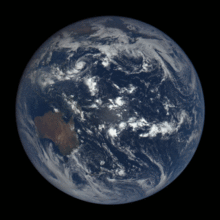
Earth's rotation or Earth's spin is the
The
Earth rotates once in about 24 hours with respect to the Sun, but once every 23 hours, 56 minutes and 4 seconds with respect to other distant stars (see below). Earth's rotation is slowing slightly with time; thus, a day was shorter in the past. This is due to the tidal effects the Moon has on Earth's rotation. Atomic clocks show that the modern day is longer by about 1.7 milliseconds than a century ago,[1] slowly increasing the rate at which UTC is adjusted by leap seconds. Analysis of historical astronomical records shows a slowing trend; the length of a day increased by about 2.3 milliseconds per century since the 8th century BCE.[2]
Scientists reported that in 2020 Earth had started spinning faster, after consistently spinning slower than 86,400 seconds per day in the decades before. On June 29, 2022, Earth's spin was completed in 1.59 milliseconds under 24 hours, setting a new record.[3] Because of that trend, engineers worldwide are discussing a 'negative leap second' and other possible timekeeping measures.[4]
This increase in speed is thought to be due to various factors, including the complex motion of its molten core, oceans, and atmosphere, the effect of celestial bodies such as the Moon, and possibly climate change, which is causing the ice at Earth's poles to melt. The masses of ice account for the Earth's shape being that of an oblate spheroid, bulging around the equator. When these masses are reduced, the poles rebound from the loss of weight, and Earth becomes more spherical, which has the effect of bringing mass closer to its centre of gravity.
History
Among the ancient Greeks, several of the Pythagorean school believed in the rotation of Earth rather than the apparent diurnal rotation of the heavens. Perhaps the first was Philolaus (470–385 BCE), though his system was complicated, including a counter-earth rotating daily about a central fire.[6]
A more conventional picture was supported by
However,
In 499 CE, the Indian astronomer Aryabhata suggested that the spherical Earth rotates about its axis daily, and that the apparent movement of the stars is a relative motion caused by the rotation of Earth. He provided the following analogy: "Just as a man in a boat going in one direction sees the stationary things on the bank as moving in the opposite direction, in the same way to a man at Lanka the fixed stars appear to be going westward."[9][10]
In the 10th century, some Muslim astronomers accepted that Earth rotates around its axis.[11] According to al-Biruni, al-Sijzi (d. c. 1020) invented an astrolabe called al-zūraqī based on the idea believed by some of his contemporaries "that the motion we see is due to the Earth's movement and not to that of the sky."[12][13] The prevalence of this view is further confirmed by a reference from the 13th century which states: "According to the geometers [or engineers] (muhandisīn), the Earth is in constant circular motion, and what appears to be the motion of the heavens is actually due to the motion of the Earth and not the stars."[12] Treatises were written to discuss its possibility, either as refutations or expressing doubts about Ptolemy's arguments against it.[14] At the Maragha and Samarkand observatories, Earth's rotation was discussed by Tusi (born 1201) and Qushji (born 1403); the arguments and evidence they used resemble those used by Copernicus.[15]
In medieval Europe,
Empirical tests
Earth's rotation implies that the Equator bulges and the geographical poles are flattened. In his Principia, Newton predicted this flattening would amount to one part in 230, and pointed to the pendulum measurements taken by Richer in 1673 as corroboration of the change in gravity,[23] but initial measurements of meridian lengths by Picard and Cassini at the end of the 17th century suggested the opposite. However, measurements by
In Earth's rotating frame of reference, a freely moving body follows an apparent path that deviates from the one it would follow in a fixed frame of reference. Because of the
Hooke, following a suggestion from Newton in 1679, tried unsuccessfully to verify the predicted eastward deviation of a body dropped from a height of 8.2 meters, but definitive results were obtained later, in the late 18th and early 19th centuries, by
The most celebrated test of Earth's rotation is the
Periods
True solar day
Earth's
Mean solar day
The average of the true solar day during the course of an entire year is the mean solar day, which contains 86,400 mean solar seconds. Currently, each of these seconds is slightly longer than an
The
Stellar and sidereal day
Earth's rotation period relative to the
Both the stellar day and the sidereal day are shorter than the mean solar day by about 3 minutes 56 seconds. This is a result of the Earth turning 1 additional rotation, relative to the celestial reference frame, as it orbits the Sun (so 366.24 rotations/y). The mean solar day in SI seconds is available from the IERS for the periods 1623–2005[38] and 1962–2005.[39]
Recently (1999–2010) the average annual length of the mean solar day in excess of 86,400 SI seconds has varied between 0.25 ms and 1 ms, which must be added to both the stellar and sidereal days given in mean solar time above to obtain their lengths in SI seconds (see
Angular speed
The
The tangential speed of Earth's rotation at a point on Earth can be approximated by multiplying the speed at the equator by the cosine of the latitude.[42] For example, the Kennedy Space Center is located at latitude 28.59° N, which yields a speed of: cos(28.59°) × 1,674.4 km/h = 1,470.2 km/h. Latitude is a placement consideration for spaceports.
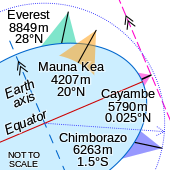
The peak of the Cayambe volcano is the point of Earth's surface farthest from its axis; thus, it rotates the fastest as Earth spins.[43]
Changes
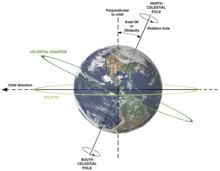
In rotational axis
Earth's rotation axis moves with respect to the fixed stars (
Precession is a rotation of Earth's rotation axis, caused primarily by external torques from the gravity of the Sun, Moon and other bodies. The polar motion is primarily due to free core nutation and the Chandler wobble.
In rotational speed
Tidal interactions
Over millions of years, Earth's rotation has been slowed significantly by tidal acceleration through gravitational interactions with the Moon. Thus angular momentum is slowly transferred to the Moon at a rate proportional to , where is the orbital radius of the Moon. This process has gradually increased the length of the day to its current value, and resulted in the Moon being
This gradual rotational deceleration is empirically documented by estimates of day lengths obtained from observations of
Resonant stabilization
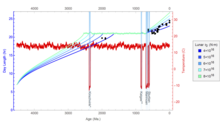
The current rate of tidal deceleration is anomalously high, implying Earth's rotational velocity must have decreased more slowly in the past. Empirical data[44] tentatively shows a sharp increase in rotational deceleration about 600 Myr ago. Some models suggest that Earth maintained a constant day length of 21 hours throughout much of the Precambrian.[45] This day length corresponds to the semidiurnal resonant period of the thermally driven atmospheric tide; at this day length, the decelerative lunar torque could have been canceled by an accelerative torque from the atmospheric tide, resulting in no net torque and a constant rotational period. This stabilizing effect could have been broken by a sudden change in global temperature. Recent computational simulations support this hypothesis and suggest the Marinoan or Sturtian glaciations broke this stable configuration about 600 Myr ago; the simulated results agree quite closely with existing paleorotational data.[47]
Global events
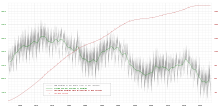
Some recent large-scale events, such as the
The length of the day can also be influenced by man-made structures. For example, NASA scientists calculated that the water stored in the Three Gorges Dam has increased the length of Earth's day by 0.06 microseconds due to the shift in mass.[50]
Measurement
The primary monitoring of Earth's rotation is performed by
The absolute value of Earth rotation includingAncient observations
There are recorded observations of
Cyclic variability
Around every 25–30 years Earth's rotation slows temporarily by a few milliseconds per day, usually lasting around five years. 2017 was the fourth consecutive year that Earth's rotation has slowed. The cause of this variability has not yet been determined.[57]
Origin

Earth's original rotation was a vestige of the original
However, if the giant-impact hypothesis for the origin of the Moon is correct, this primordial rotation rate would have been reset by the Theia impact 4.5 billion years ago. Regardless of the speed and tilt of Earth's rotation before the impact, it would have experienced a day some five hours long after the impact.[59] Tidal effects would then have slowed this rate to its modern value.
See also
- Allais effect
- Diurnal cycle
- Earth's orbit
- Earth orientation parameters
- Formation and evolution of the Solar System
- Geodesic (in mathematics)
- Geodesics in general relativity
- Geodesy
- History of Earth
- History of geodesy
- Inner core super-rotation
- List of important publications in geology
- Nychthemeron
- Rossby wave
- Spherical Earth
- World Geodetic System
Notes
- ^ See Fallexperimente zum Nachweis der Erdrotation (German Wikipedia article).
- ^ When Earth's eccentricity exceeds 0.047 and perihelion is at an appropriate equinox or solstice, only one period with one peak balances another period that has two peaks.[27]
- ^ Aoki, the ultimate source of these figures, uses the term "seconds of UT1" instead of "seconds of mean solar time".[36]
- ^ It can be established that SI seconds apply to this value by following the citation in "USEFUL CONSTANTS" to E. Groten "Parameters of Common Relevance of Astronomy, Geodesy, and Geodynamics" Archived 21 March 2019 at the Wayback Machine which states units are SI units, except for an instance not relevant to this value.
- ^ In astronomy, unlike geometry, 360° means returning to the same point in some cyclical time scale, either one mean solar day or one sidereal day for rotation on Earth's axis, or one sidereal year or one mean tropical year or even one mean Julian year containing exactly 365.25 days for revolution around the Sun.
References
- ISBN 978-3-527-62795-0.
- .
- ^ Robert Lea (3 August 2022). "Earth sets record for the shortest day". Space.com. Retrieved 8 August 2022.
- ^ Knapton, Sarah (4 January 2021). "The Earth is spinning faster now than at any time in the past half century". The Telegraph. Retrieved 11 February 2021.
- ^ Pappas, Stephanie (25 September 2018). "Humans Contribute to Earth's Wobble, Scientists Say". Scientific American. Retrieved 12 August 2022.
- S2CID 144330867.
- ^ Aristotle. Of the Heavens. Book II, Ch 13. 1.
- ^ Ptolemy. Almagest Book I, Chapter 8.
- ^ "Archived copy" (PDF). Archived from the original (PDF) on 13 December 2013. Retrieved 8 December 2013.
{{cite web}}: CS1 maint: archived copy as title (link) - ISBN 978-0-691-12067-6.
- ^ Alessandro Bausani (1973). "Cosmology and Religion in Islam". Scientia/Rivista di Scienza. 108 (67): 762.
- ^ ISBN 9780521028875.
- ISBN 9781438414195.
- ISBN 978-0-387-31022-0. (PDF version)
- S2CID 145372613
- ^ Aquinas, Thomas. Commentaria in libros Aristotelis De caelo et Mundo. Lib II, cap XIV. trans in Grant, Edward, ed. (1974). A Source Book in Medieval Science. Harvard University Press. pages 496–500
- ^ Buridan, John (1942). Quaestiones super libris quattuo De Caelo et mundo. pp. 226–232. in Grant 1974, pp. 500–503
- ^ Oresme, Nicole. Le livre du ciel et du monde. pp. 519–539. in Grant 1974, pp. 503–510
- ^ Copernicus, Nicolas. On the Revolutions of the Heavenly Spheres. Book I, Chap 5–8.
- ^ Gilbert, William (1893). De Magnete, On the Magnet and Magnetic Bodies, and on the Great Magnet the Earth. New York, J. Wiley & sons. pp. 313–347.
- ^ ISBN 9789027703118.
- arXiv:1103.2057.
- ^ Newton, Isaac (1846). Newton's Principia. Translated by A. Motte. New-York : Published by Daniel Adee. p. 412.
- ISBN 9780226749471.
- ^ "Starry Spin-up". Retrieved 24 August 2015.
- ^ "What Is Solar Noon?". timeanddate.com. Retrieved 15 July 2022.
- ^ ISBN 978-0-943396-51-4.
- ^ Ricci, Pierpaolo. "pierpaoloricci.it/dati/giorno solare vero VERSIONE EN". Pierpaoloricci.it. Retrieved 22 September 2018.
- ^ "INTERNATIONAL EARTH ROTATION AND REFERENCE SYSTEMS SERVICE : EARTH ORIENTATION PARAMETERS : EOP (IERS) 05 C04". Hpiers.obspm.fr. Retrieved 22 September 2018.
- ^ "Physical basis of leap seconds" (PDF). Iopscience.iop.org. Retrieved 22 September 2018.
- ^ Leap seconds Archived 12 March 2015 at the Wayback Machine
- ^ "Prediction of Universal Time and LOD Variations" (PDF). Ien.it. Archived from the original (PDF) on 28 February 2008. Retrieved 22 September 2018.
- ^ R. Hide et al., "Topographic core-mantle coupling and fluctuations in the Earth's rotation" 1993.
- ^ Leap seconds by USNO Archived 12 March 2015 at the Wayback Machine
- ^ a b c d "USEFUL CONSTANTS". Hpiers.obspm.fr. Retrieved 22 September 2018.
- ^ Aoki, et al., "The new definition of Universal Time", Astronomy and Astrophysics 105 (1982) 359–361.
- ISBN 978-0-935702-68-2.
- ^ IERS Excess of the duration of the day to 86,400s … since 1623 Archived 3 October 2008 at the Wayback Machine Graph at end.
- ^ "Excess to 86400s of the duration day, 1995–1997". 13 August 2007. Archived from the original on 13 August 2007. Retrieved 22 September 2018.
- ^ Arthur N. Cox, ed., Allen's Astrophysical Quantities p.244.
- ^ Michael E. Bakich, The Cambridge planetary handbook, p.50.
- ^ Butterworth & Palmer. "Speed of the turning of the Earth". Ask an Astrophysicist. NASA Goddard Spaceflight Center. Archived from the original on 8 January 2019. Retrieved 3 February 2019.
- ^ Klenke, Paul. "Distance to the Center of the Earth". Summit Post. Retrieved 4 July 2018.
- ^ S2CID 51948507.
- ^ PMID 11542096.
- ISBN 9783540090465.
- ^ S2CID 36308735.
- ^ Sumatran earthquake sped up Earth's rotation, Nature, 30 December 2004.
- .
- ^ "NASA Details Earthquake Effects on the Earth". NASA/JPL. Retrieved 22 March 2019.
- ^ "Permanent monitoring". Hpiers.obspm.fr. Retrieved 22 September 2018.
- .
- S2CID 134160047.
- ISBN 9780521461948, retrieved 15 July 2022
- .
- PMID 28119545.
- ^ Nace, Trevor. "Earth's Rotation Is Mysteriously Slowing Down: Experts Predict Uptick In 2018 Earthquakes". Forbes. Retrieved 18 October 2019.
- ^ "Why do planets rotate?". Ask an Astronomer.
- .
External links
- USNO Earth Orientation Archived 14 May 2011 at the Wayback Machine new site, being populated
- USNO IERS old site, to be abandoned
- IERS Earth Orientation Center: Earth rotation data and interactive analysis
- International Earth Rotation and Reference Systems Service (IERS)
- If the Earth's rotation period is less than 24 hours, why don't our clocks fall out of sync with the Sun?


